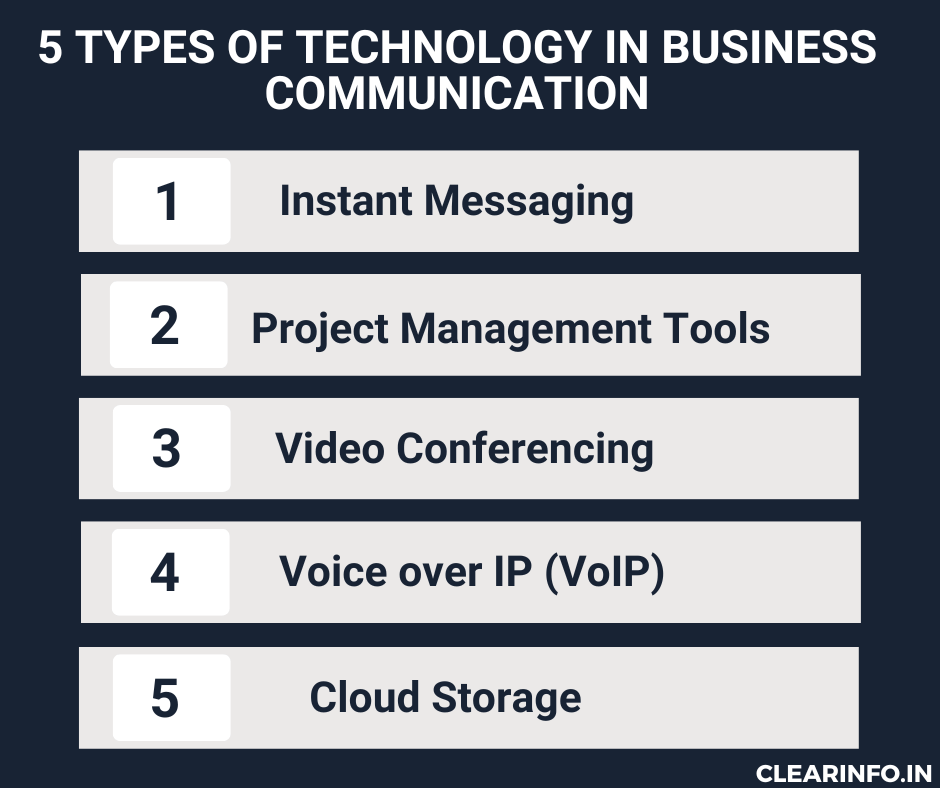The use of technology in business communication has opened up new opportunities for organizations to streamline their operations, collaborate with teams across different locations, and build strong relationships with customers.
From instant messaging platforms to video conferencing tools, businesses are leveraging technology to enhance their communication capabilities and achieve their objectives.
However, while technology has revolutionized business communication, it has also presented its own set of challenges. In this article, we will explore technology in business communication with examples, in detail. In addition to its effects and pros and cons and role for business in current time.
What is technology in business communication?
Technology in business communication refers to the various tools and systems that enable individuals and organizations to communicate more efficiently and effectively in a business context.
This can include technologies such as email, instant messaging, video conferencing, project management software, customer relationship management (CRM) systems, and more.
Through the utilization of technology in business communication, organizations can enhance their operational efficiency, cut short expenses, and boost productivity. For example, employees can easily share documents and collaborate on projects in real time, while managers can monitor progress and provide feedback remotely.
Apart from enhancing efficiency and productivity, the technology utilized in business communication also contributes to enhancing the customer experience. In fact, a report by LinkedIn has shown that 96% of the survey participants consider customer service to be a crucial factor in determining their loyalty toward a brand.
Therefore by leveraging digital tools, businesses can provide faster and more responsive customer service, leading to increased customer satisfaction and loyalty.
Additionally, technology in business communication is an essential component of modern business operations, enabling organizations to communicate and collaborate more effectively and efficiently, while also improving the overall customer experience.
Therefore, being updated with the latest technological advancements can enable businesses to remain competitive and position themselves for long-term success.
Why is technology important in business communication?
By leveraging the latest communication tools and technologies, businesses can communicate more effectively and gain a competitive edge in the market. There are several reasons why technology plays a vital role in business communication:
1/ Cost-Effective: Technology reduces the cost of communication and enables businesses to operate more efficiently. For example, video conferencing reduces the need for travel and allows businesses to conduct meetings with individuals in different locations without incurring significant expenses.
2/ Data Analysis: Technology provides businesses with valuable data that can be used to improve communication strategies. Companies can analyze communication patterns and identify areas for improvement, leading to more effective communication practices.
3/ Competitive Advantage: The adoption of technology for business communication can provide businesses with a competitive advantage in the market. By streamlining communication and enhancing efficiency, businesses can improve their overall performance and provide better services to customers.
4/ Improved Collaboration: Technology simplifies team collaboration and enables them to work on projects together seamlessly, regardless of their geographical location. Cloud-based software solutions allow teams to share files, access resources, and communicate in real time.
This is particularly crucial for businesses offering a software development service, where coordination between developers, testers, and project managers is vital across distributed teams.
5/ Enhanced Customer Service: Technology allows businesses to communicate with customers more efficiently and provide them with better service. With tools like chatbots and social media monitoring, businesses can respond to customer queries and concerns quickly, leading to higher customer satisfaction.
What is an example of technology in business communication?
There are many ways in which businesses can leverage technology in their daily operations. For example, we use video conferencing software, such as Zoom or Google Meet for our business communication. Video conferencing allows our teams to collaborate remotely, regardless of their location, and communicate face-to-face in real-time.

This can work for other organizations as well, for instance, if a company has offices in different parts of the world, and its team members need to work on a project together. Instead of gathering in one location, they can use video conferencing software to communicate and collaborate remotely.
During a video conference, team members can share their screens, present information, and discuss ideas as if they were in the same room. This not only saves time and money but also allows team members to work more efficiently and effectively, improving overall productivity.
Furthermore, video conferencing can also be used to conduct virtual meetings with clients or customers, providing a more personal and engaging experience than traditional phone or email communication.
Types of Technology in Business Communication
There are various types of technology that allow businesses to communicate and reach a wider audience. Here are some of the most common types:  1/ Instant Messaging: Real-time communication among teams is facilitated through instant messaging (IM) platforms such as Slack. IM offers a more informal communication channel than email and allows for quick and efficient collaboration.
1/ Instant Messaging: Real-time communication among teams is facilitated through instant messaging (IM) platforms such as Slack. IM offers a more informal communication channel than email and allows for quick and efficient collaboration.

2/ Project Management Tools: Businesses can have a centralized platform to manage tasks, deadlines, and project progress through project management tools such as Trello or Asana. It enables team members to collaborate and communicate effectively while working on projects.
3/ Video Conferencing: Video conferencing software enables businesses to conduct virtual meetings with team members, clients, and partners in different locations. It offers face-to-face communication, screen sharing, and file-sharing capabilities.
4/ Voice over IP (VoIP): VoIP technology allows businesses to make voice calls over the internet, reducing the need for traditional telephone lines. This can be a cost-effective solution, particularly for businesses that frequently make long-distance calls.
5/ Cloud Storage: Businesses can securely store and share files through cloud storage platforms such as Dropbox or Google Drive, which are easily accessible. They enable team members to access files from any location and collaborate on documents in real-time.
Effects of Technology on business communication
The effects of technology on business communication are significant, and they have transformed the way businesses communicate and operate. Here are some of the most notable effects:
- Reduced Communication Costs: Technology has reduced the cost of business communication, providing cost-effective solutions for businesses to communicate and collaborate. As a result, businesses can save money on travel, phone bills, and other communication expenses.
- Increased Data Availability: Technology has provided businesses with more data on communication patterns, enabling them to analyze their communication strategies and identify areas for improvement. This has led to more effective communication practices and better decision-making.
- Improved Customer Service: Technology has enabled businesses to improve their customer service by providing customers with faster response times, self-service options, and personalized communication. Which leads to higher customer satisfaction and retention rates.
- Improved Time Management: Technology has made it easier for businesses to manage their time effectively, with tools such as email scheduling, project management software, and automation. This has enabled businesses to allocate their time more efficiently and enhance their productivity.
- Enhanced Security: Technology has enabled businesses to communicate more securely, with encryption and other security measures ensuring that communication remains private and confidential. This has helped to protect sensitive business information and prevent data breaches.
In summary, technology has had a significant impact on business communication, enabling businesses to communicate more efficiently, and leading to improved business performance and success.
Advantages and disadvantages of technology in business communication
Advantages of technology in business communication
1/ Speed and Efficiency: Technology has made communication faster and more efficient. Messages can be sent and received instantly, which allows businesses to communicate and respond to customers and colleagues more quickly.
2/ Analytics: Technology provides businesses with data and analytics that can help them improve their communication strategies. Businesses can optimize their communication channels and messages to cater to their customers’ needs better by monitoring metrics such as engagement, open rates, and click-through rates.
3/ Flexibility: Technology has made it easier for businesses to offer flexible work arrangements, such as remote work, which can increase employee satisfaction and productivity. Employees can work from any location and at any time as they have the flexibility to communicate and collaborate online.
4/ Cost savings: Technology has enabled businesses to save on communication costs. For instance, video conferencing has reduced the need for travel, while email and messaging have reduced the need for phone calls and physical mail.
5/ Innovation and business growth: Technology has enabled businesses to innovate and develop new products and services by providing communication tools that enable collaboration between team members and clients.
Disadvantages of technology in business communication
1/ Security risks: As the utilization of technology for communication increases, the risk of cyber-attacks and data breaches has also risen. Companies must be mindful of these risks and take appropriate measures to safeguard their communication channels and data.
2/ Technical issues: Technology can sometimes fail, causing communication breakdowns and delays. Technical issues can also be frustrating for employees and customers, leading to lost productivity and revenue.
3/ Language barriers: Technology-based communication can be challenging for businesses dealing with clients and customers who speak different languages. Automated translation systems are not always accurate, and miscommunication can occur, leading to confusion and mistakes.
Related Reading: Technology barriers in business communication
3/ Reduced privacy: Technology-based communication can compromise privacy and confidentiality. Email and messaging systems may not be secure, leading to the risk of data breaches and the loss of sensitive information.
Related Reading: Pros and Cons of Email for company communications
4/ Limited social cues: The effectiveness of technology-based communication may be limited in conveying social cues such as tone of voice, facial expressions, and body language. This can make it difficult to interpret the intended meaning of a message.
Role of information technology in business communication
Information technology (IT) plays a critical role in business communication. It facilitates businesses to communicate efficiently and promptly with their employees, customers, and other stakeholders. Based on our own experiences here are some of the ways that IT contributes to business communication:
- Cloud computing: Cloud-based services like Google Drive, Dropbox, and OneDrive allow businesses to store and share files and documents securely in the cloud. This makes it easier for teams to collaborate and access information from anywhere, at any time.
- Voice over Internet Protocol (VoIP): VoIP technology allows businesses to make phone calls over the Internet, rather than traditional phone lines. This can save businesses money on phone bills and enable more flexible communication, as VoIP calls can be made from anywhere with an internet connection.
- Data analytics: IT tools like data analytics software can help businesses analyze communication patterns and identify areas for improvement. By analyzing communication data, businesses can gain insights into which channels and strategies are most effective, and adjust their communication strategies accordingly.
- Customer relationship management (CRM): CRM software leverages IT to oversee customer interactions, analyze customer behavior, and track customer data. This, in turn, assists businesses in enhancing their communication with customers and offering improved customer service.
How can technology be used to improve business communication?
Technology has revolutionized the way businesses communicate with their customers, and employees, by offering various communication channels to suit different preferences.
Chatbots, for instance, can provide 24/7 customer support by answering frequently asked questions and directing customers to the appropriate resources. Furthermore, video conferencing tools like Zoom and Microsoft Teams have made it possible for businesses to hold virtual meetings, interviews, and training sessions without the need for physical presence. T
his not only saves time and money but also enables businesses to reach a wider audience regardless of geographical location.
In conclusion, technology has brought about significant improvements in business communication by offering various communication channels, automating routine tasks, and enabling remote collaboration.
As technology continues to advance, it is essential for businesses to embrace and leverage these tools to stay competitive and enhance their communication capabilities.
How do businesses use communication technology to improve performance
Businesses use communication technology to improve performance in a number of ways:
- Marketing and Advertising: Social media, email marketing, and other communication tools can be used to reach customers and promote products or services more effectively, improving sales and revenue.
- Data Management: The utilization of communication technology can enhance the efficiency of data collection and management, empowering businesses to enhance their overall performance and achieve their business communication goals and objectives.
- Training and Development: By leveraging communication technology, businesses can provide training and development programs to their employees, leading to the improvement of their skills and knowledge, and ultimately resulting in benefits for the organization.
- Improved Decision Making: Access to real-time data and analytics provided by communication technology empowers businesses to make efficient and well-informed decisions promptly.
How VoIP technology improves productivity in business communication
VoIP technology can offer a range of benefits to businesses for enhancing their productivity.
- VoIP eliminates the need for separate networks for voice and data.
- Real-time collaboration through video conferencing, screen sharing, and instant messaging is made possible by VoIP technology.
- VoIP allows businesses to integrate their communication systems with other business applications such as CRM, project management, and customer support software.
- VoIP offers advanced call management features such as call forwarding, voicemail, call routing, and call recording.
Check out the following blog by Intermedia on the benefits of VoIP for small businesses.
What are some good books on business communication for IT specialists?
- “Leading Change” by John P. Kotter
- “The Lean Startup: How Today’s Entrepreneurs Use Continuous Innovation to Create Radically Successful Businesses” by Eric Ries.
- “The Communication Book: 44 Ideas for Better Conversations Every Day” by Mikael Krogerus and Roman Tschäppeler.
- “Difficult Conversations: How to Discuss What Matters Most” by Douglas Stone, Bruce Patton, and Sheila Heen
- “Influence: The Psychology of Persuasion” by Robert Cialdini.
Related Reading: Top 10 business communication books for Professional
Frequently Asked Questions
Q1) How can technology be used to improve business communication?
Ans: Technology can improve business communication in several ways. Firstly, it can help facilitate faster communication by enabling real-time messaging, video conferencing, and cloud-based file sharing. Additionally, it can also help to automate routine tasks, such as sending reminders and scheduling meetings, which can save time and reduce errors.
Q2) What are the benefits of technology in business?
Ans: Technology can benefit businesses by helping them to reach a wider audience, by using social media and online advertising. This can help businesses grow and increase their revenue. Finally, technology can also provide businesses with valuable data and insights, which can help them make more informed decisions about their operations and strategies.



